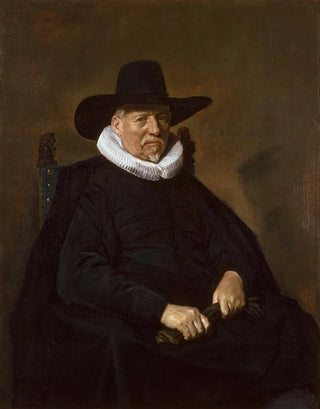Art print Portrait of an elderly man traditionally called Heer Bodolphe - Frans Hals | Art print


View from behind

Frame (optional)
Portrait of an Elderly Man - Frans Hals – Captivating Introduction
In the world of art, some works transcend mere representation to become windows into the human soul. The "Portrait of an Elderly Man" by Frans Hals is one of those captivating and intriguing pieces. Created in the 17th century, this painting embodies not only the technical virtuosity of its creator but also the psychological depth of the characters it depicts. Through this portrait, Hals manages to capture the essence of a man, revealing emotions and stories hidden behind a face marked by time. The artwork, through its composition and treatment of light and shadow, invites viewers to reflect on this man's life, his experiences, and his role in the society of his time.
Style and uniqueness of the work
Frans Hals's style is immediately recognizable, and this portrait is no exception. The brushwork, both swift and precise, imparts an astonishing vitality to the subjects it portrays. In the "Portrait of an Elderly Man," the brushstrokes seem to dance across the canvas, creating a rich texture that brings to life the wrinkled skin and graying hair of the protagonist. This realism, combined with a certain expressiveness, allows us to grasp not only the physical appearance of the man but also a part of his character. Hals skillfully plays with light, highlighting facial features while gently shading the rest of the composition. This duality between light and shadow accentuates the intensity of the old man's gaze, inviting the viewer to establish an emotional connection with him. Every detail, from the pleats of his collar to the sparkle in his eyes, is carefully orchestrated to tell a story that goes far beyond a simple portrait.
The artist and his influence
Frans Hals, an emblematic figure of the Dutch Golden Age, left an indelible mark on art history. Born in Antwerp in 1582, he settled in Haarlem, where he developed a unique style that influenced many contemporary and future artists. His ability to capture the humanity of individuals, whether

Matte finish

View from behind

Frame (optional)
Portrait of an Elderly Man - Frans Hals – Captivating Introduction
In the world of art, some works transcend mere representation to become windows into the human soul. The "Portrait of an Elderly Man" by Frans Hals is one of those captivating and intriguing pieces. Created in the 17th century, this painting embodies not only the technical virtuosity of its creator but also the psychological depth of the characters it depicts. Through this portrait, Hals manages to capture the essence of a man, revealing emotions and stories hidden behind a face marked by time. The artwork, through its composition and treatment of light and shadow, invites viewers to reflect on this man's life, his experiences, and his role in the society of his time.
Style and uniqueness of the work
Frans Hals's style is immediately recognizable, and this portrait is no exception. The brushwork, both swift and precise, imparts an astonishing vitality to the subjects it portrays. In the "Portrait of an Elderly Man," the brushstrokes seem to dance across the canvas, creating a rich texture that brings to life the wrinkled skin and graying hair of the protagonist. This realism, combined with a certain expressiveness, allows us to grasp not only the physical appearance of the man but also a part of his character. Hals skillfully plays with light, highlighting facial features while gently shading the rest of the composition. This duality between light and shadow accentuates the intensity of the old man's gaze, inviting the viewer to establish an emotional connection with him. Every detail, from the pleats of his collar to the sparkle in his eyes, is carefully orchestrated to tell a story that goes far beyond a simple portrait.
The artist and his influence
Frans Hals, an emblematic figure of the Dutch Golden Age, left an indelible mark on art history. Born in Antwerp in 1582, he settled in Haarlem, where he developed a unique style that influenced many contemporary and future artists. His ability to capture the humanity of individuals, whether
12,34 €






